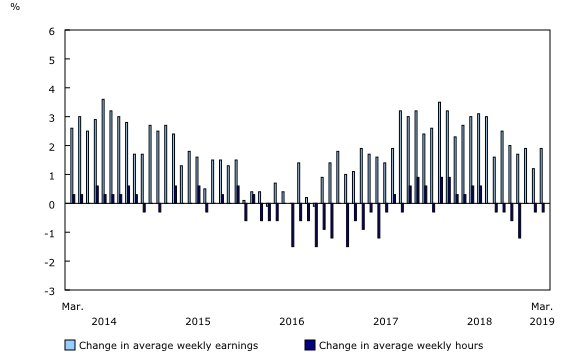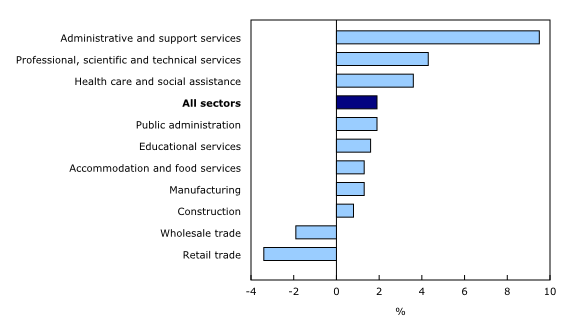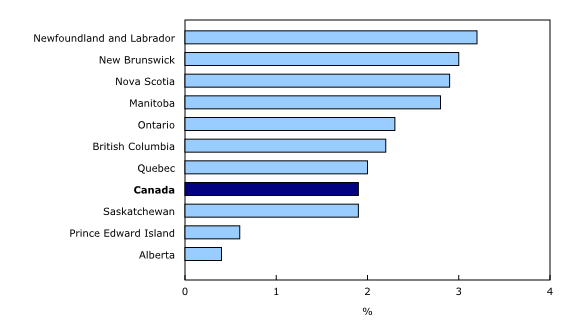Payroll employment, earnings and hours, March 2019
Archived Content
Information identified as archived is provided for reference, research or recordkeeping purposes. It is not subject to the Government of Canada Web Standards and has not been altered or updated since it was archived. Please "contact us" to request a format other than those available.
Released: 2019-05-30
$1,016.41
March 2019
1.9% 
(12-month change)
$1,063.17
March 2019
3.2% 
(12-month change)
$847.21
March 2019
0.6% 
(12-month change)
$892.36
March 2019
2.9% 
(12-month change)
$929.99
March 2019
3.0% 
(12-month change)
$949.89
March 2019
2.0% 
(12-month change)
$1,037.63
March 2019
2.3% 
(12-month change)
$958.09
March 2019
2.8% 
(12-month change)
$1,028.70
March 2019
1.9% 
(12-month change)
$1,159.15
March 2019
0.4% 
(12-month change)
$985.00
March 2019
2.2% 
(12-month change)
$1,174.76
March 2019
8.1% 
(12-month change)
$1,417.92
March 2019
1.0% 
(12-month change)
$1,412.18
March 2019
4.4% 
(12-month change)
Average weekly earnings of non-farm payroll employees were $1,016 in March, up 0.8% from February following four months of little change. Compared with 12 months earlier, earnings grew by 1.9%.
In general, changes in weekly earnings reflect a number of factors, including wage growth; changes in the composition of employment by industry, occupation and level of job experience; and average hours worked per week.
Non-farm payroll employees worked an average of 32.8 hours per week in March, little changed from both the previous month and 12 months earlier.
To explore the most recent results of the Survey of Employment, Payrolls and Hours in an interactive format, visit the "Earnings and payroll employment in brief: Interactive app."
Average weekly earnings by sector
Compared with 12 months earlier, average weekly earnings increased in 5 of the 10 largest industrial sectors, led by administrative and support services. At the same time, earnings declined in retail trade and were little changed in accommodation and food services, manufacturing, construction and wholesale trade.
In administrative and support services, average weekly earnings rose by 9.5% to $866 in March, mostly due to increases in employment services and services to buildings and dwellings. Weekly earnings in the sector grew in the majority of the provinces, with Ontario and Quebec contributing the most to the growth. Earnings in administrative and support services have been on a marked upward trend since November 2018.
In the 12 months to March, earnings in professional, scientific and technical services grew by 4.3% to $1,428, largely due to employment gains in the high-paying computer systems design and related services industries. At the same time, earnings were up notably in management, scientific and technical services, as well as in legal services. Ontario, Quebec and British Columbia were the largest contributors to the higher earnings in the sector.
For payroll employees in health care and social assistance, earnings were up 3.6% to $926 in March, driven by gains in Ontario. At the subsector level, ambulatory health care services and hospitals contributed the most to the increase.
Average weekly earnings in public administration rose by 1.9% to $1,325 in March, mostly due to employment and earnings gains in federal as well as provincial and territorial public administration. Provincially, Quebec was the largest contributor to the increase in earnings in public administration.
Year over year, average weekly earnings in educational services increased by 1.6% to $1,065, mainly driven by earnings gains in elementary and secondary schools, and higher employment in universities.
In March, earnings for payroll employees in retail trade declined 3.4% to $584. Earnings in this sector have been trending downward since December 2018. In the 12 months to March, general merchandise stores as well as food and beverage stores contributed the most to the decrease. These declines were tempered by gains in motor vehicle and parts dealers. Earnings in retail trade fell in all provinces. Nationally, hours worked in this sector fell by 5.6%, from an average of 28.7 hours to 27.0 hours per week.
Average weekly earnings by province
In the 12 months to March, average weekly earnings grew in eight provinces, led by Newfoundland and Labrador. At the same time, earnings were little changed in Prince Edward Island and Alberta.
In Newfoundland and Labrador, average weekly earnings rose by 3.2% to $1,063 in March. Increased earnings in mining, quarrying and oil and gas extraction and in administrative and support services, as well as employment gains in construction, contributed the most to the rise.
Average weekly earnings in New Brunswick increased by 3.0% to $930 in March, with educational services contributing the most to the growth. Year over year, average weekly hours worked across all sectors in the province rose by 1.2%.
Earnings in Nova Scotia grew 2.9% year over year to $892, with gains spread across many sectors. Health care and social assistance, wholesale trade and construction were the largest contributors to the rise.
Compared with March 2018, earnings in Manitoba were up 2.8% to $958, driven by higher earnings in educational services and in transportation and warehousing, as well as by increased employment and earnings in manufacturing. This growth was moderated by a notable earnings decline in retail trade.
Compared with 12 months earlier, average weekly earnings in Ontario increased by 2.3% to $1,038. Professional, scientific and technical services, health care and social assistance, as well as manufacturing were the largest contributors to the growth.
For payroll employees in British Columbia, average earnings were up 2.2% to $985 in March. Health care and social assistance contributed the most to the rise, while earnings declined notably in wholesale trade.
In Quebec, average weekly earnings grew by 2.0% to $950 in March, with increases across the majority of the sectors. Construction, as well as professional, scientific and technical services led the gains.
From March 2018 to March 2019, earnings in Saskatchewan rose by 1.9% to $1,029. Health care and social assistance was the largest contributor to the growth, while decreased employment in construction and lower earnings in wholesale trade moderated the overall increase.
Non-farm payroll employment by sector
The number of non-farm payroll employees increased by 27,500 from February to March. The largest monthly gains were in educational services; professional, scientific and technical services; and health care and social assistance. At the same time, payroll employment declined in manufacturing, administrative and support services, construction and wholesale trade.
In the 12 months to March, the number of payroll employees rose by 354,900 (+2.1%). Employment increased in almost all sectors, led by health care and social assistance (+70,300 or +3.6%), retail trade (+47,100 or +2.4%) and professional, scientific and technical services (+39,200 or +4.3%). At the same time, payroll employment declined in information and cultural industries (-10,300 or -3.0%) and mining, quarrying, and oil and gas extraction (-3,200 or -1.6%).
Spotlight: Manufacturing
In March, about 1.6 million employees worked in the manufacturing sector, accounting for 9.4% of total payroll employment in Canada. The average manufacturing payroll employee worked 37.4 hours per week in March, and earned $1,109. Nearly three-quarters of those employed in this sector worked in either Ontario (43.8%) or Quebec (28.3%).
According to the Labour Force Survey (LFS), men accounted for the majority (72.6%) of all employment in the manufacturing sector in 2018, with this share varying by only a few percentage points since the series began in 1976. There was more variation by age, with the share of workers aged 15 to 24 declining notably over time, from 23.9% in 1976 to 8.5% in 2018. The decrease in the share of younger workers has largely been replaced by workers aged 55 and older, whose share grew from 10.6% in 1976 to 23.7% in 2018.
The manufacturing sector encompasses 21 diverse subsectors, ranging from clothing to primary metal manufacturing. Food manufacturing and transportation equipment manufacturing have historically been the largest two subsectors since the beginning of both the Survey of Employment, Payrolls and Hours (SEPH) and the LFS series. According to SEPH data, food manufacturing represented 15.3% of payroll employment in manufacturing in March, up from 11.6% in January 2001. Transportation equipment manufacturing, meanwhile, represented 13.1% of payroll employment in the sector in March and 12.3% in January 2001.
Based on LFS data, fewer employees in manufacturing were covered by a union in 2018 (24.7%) compared with 1997 (36.4%). The decrease was largest for men, whose rate of union coverage declined from 40.8% in 1997 to 27.6% in 2018. Over the same period, the percentage of women covered by a union decreased from 24.9% to 16.8%. The overall decline in the rate of unionization among employees in manufacturing was widespread across most subsectors. In food manufacturing, the rate decreased from 39.8% in 1997 to 30.9% in 2018, while in transportation equipment manufacturing, it declined from 53.7% to 33.4%.
Average weekly earnings in food manufacturing ($904) remained below the average of the sector in March, while earnings in transportation equipment manufacturing were $1,208.
As of March, employment in manufacturing remained below its previous high. At the beginning of the SEPH series in January 2001, payroll employment in the sector was over 2.0 million, declining sharply over the next several years to below 1.5 million by the first half of 2009. Payroll employment in manufacturing subsequently remained relatively flat, until it began trending upwards in 2016. From March of that year to March 2019, payroll employment in the sector rose by over 100,800, or by 6.8%, with most of the increase occurring in food, transportation equipment, machinery, and fabricated metal product manufacturing. At the same time, earnings growth in the sector was lower over the period, at 1.7%, partly due to earnings being little changed in many of the largest subsectors. The relatively strong increase in payroll employment in manufacturing since 2016 could signal a potential for renewed strength in the sector after several years of losses and little growth.
Sustainable Development Goals
On January 1, 2016, the world officially began implementation of the 2030 Agenda for Sustainable Development—the United Nations' transformative plan of action that addresses urgent global challenges over the next 15 years. The plan is based on 17 specific sustainable development goals.
The Survey of Employment, Payrolls and Hours is an example of how Statistics Canada supports the reporting on the Global Goals for Sustainable Development. This release will be used in helping to measure the following goals:


Note to readers
The SEPH is produced by a combination of a census of approximately one million payroll deductions provided by the Canada Revenue Agency, and the Business Payrolls Survey, which collects data from a sample of 15,000 establishments. Federal, provincial and territorial public administration data are collected from various administrative records provided by these levels of government. The key objective of the SEPH is to provide a monthly portrait of the level of earnings and the number of jobs and hours worked by detailed industry at the national, provincial and territorial levels.
Estimates of average weekly earnings and hours worked are based on a sample and are therefore subject to sampling variability. This analysis focuses on differences between estimates that are statistically significant at the 68% confidence level. Payroll employment estimates are based on a census of administrative data and are not subject to sampling variability.
Statistics Canada also produces employment estimates from its Labour Force Survey (LFS). The LFS is a monthly household survey, the main objective of which is to divide the working-age population into three mutually exclusive groups: the employed (including the self-employed), the unemployed, and those not in the labour force. This survey is the official source for the unemployment rate, and collects data on the socio-demographic characteristics of all those in the labour market.
As a result of conceptual and methodological differences, estimates of changes from the SEPH and LFS do differ from time to time. However, the trends in the data are quite similar. To better understand the conceptual differences between employment measures from the LFS and SEPH, refer to section 8 of the Guide to the Survey of Employment, Payrolls and Hours (72-203-G).
Unless otherwise stated, this release presents seasonally adjusted data, which facilitate comparisons by removing the effects of seasonal variations. For more information on seasonal adjustment, see Seasonally adjusted data – Frequently asked questions.
Non-farm payroll employment data are for all hourly and salaried employees, as well as for the "other employees" category, which includes piece-rate and commission-only employees.
Unless otherwise specified, average weekly hours data are for hourly and salaried employees only and exclude businesses that could not be classified to a North American Industry Classification System (NAICS) code.
All earnings data include overtime pay and exclude businesses that could not be classified to a NAICS code. Earnings data are based on gross taxable payroll before source deductions. Average weekly earnings are derived by dividing total weekly earnings by the number of employees.
With each release, data for the current reference month are subject to revision. Data have been revised for the previous month. Users are encouraged to request and use the most up-to-date data for each month.
Real-time data tables
Real-time tables 14-10-0357-01, 14-10-0358-01, 14-10-0331-01 and 14-10-0332-01 will be updated on June 10.
Next release
Data on payroll employment, earnings and hours for April will be released on June 27.
Products
Job Vacancy Statistics (5202) from the Survey of Employment, Payrolls and Hours for February are now available.
More information about the concepts and use of the Survey of Employment, Payrolls and Hours and Job Vacancy Statistics is available in the Guide to the Survey of Employment, Payrolls and Hours (72-203-G).
The product "Earnings and payroll employment in brief: Interactive app" (14200001) is now available. This interactive visualization application provides a comprehensive picture of the Canadian labour market using the most recent data from the Survey of Employment, Payrolls and Hours. The estimates are seasonally adjusted and available by province and largest industrial sector. Historical estimates, going back 10 years, are also included. The interactive application allows users to quickly and easily explore and personalize the information presented. Combine multiple provinces and industrial sectors to create your own labour market domains of interest.
Contact information
For more information, contact us (toll-free: 1-800-263-1136; 514-283-8300; STATCAN.infostats-infostats.STATCAN@canada.ca).
To enquire about the concepts, methods or data quality of this release, contact Emmanuelle Bourbeau (613-951-3007; emmanuelle.bourbeau@canada.ca), Labour Statistics Division.
- Date modified:




